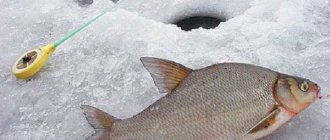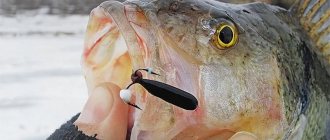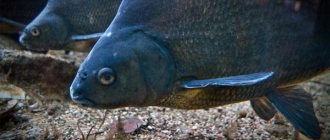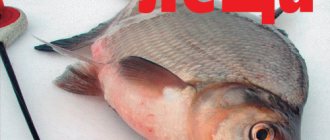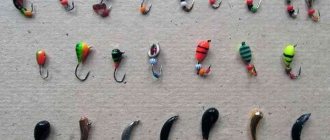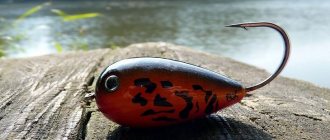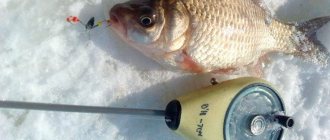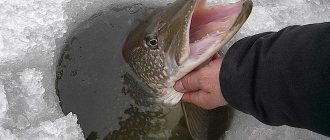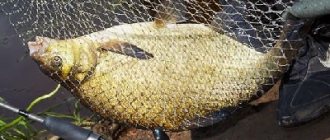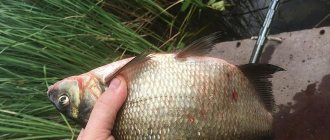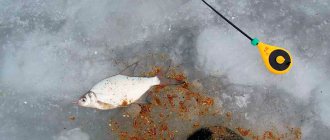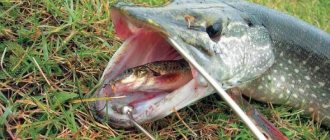Specifics of catching devils in winter
According to anglers, if you set up the devil correctly, you can achieve frequent bites. Externally the bait looks like this:
- a small tee coming out of the teardrop-shaped bait;
- colored rubber bands or cambrics.
Successful fishing will require high-quality fishing from the angler. The devil is considered better than jigs and is divided into the following groups:
- bait with a soldered tee;
- bait with hanging hook;
- with movable hooks or jellyfish.
The bodies of these groups of baits have different shapes, and they can be made of lead or tungsten. The length, as a rule, is about 1.5 cm, and the weight is from 1 g. The suspension differs from other baits, namely: it is vertical and inclined.
The choice of devils will depend on the characteristics of the reservoir and the presence of current. The elongated shape of the bait is used in still water or in places where there is a weak current.
In general, in winter you can catch not only bream, but also perch, roach and even pike perch with a devil.
What is hell?
The devil is a kind of jig in which the tee comes out of a drop-shaped body. The presented bait can be classified according to several criteria:
- The shape of the devils is elongated and round.
- By attachment to the main line - through a loop or hole in the body of the bait.
- With a rigidly fixed tee and fixed through the eye with a sufficient degree of freedom.
In addition to the above, devils differ in weight, which is selected according to fishing conditions - depth, strength of current, size of potential prey.
For reference! There are devils weighing from 0.1 to 5 or more grams.
Among the classic models there are unique varieties of devils.
A separate issue is the color of the bait. There is always a debate among anglers about the best color. Regarding the devils, many agree that black is the optimal color. However, it is possible to use jigs of a different color, from plain metal to bright fluorescent.
Equipment
Using devil bait in winter fishing requires a balanced rig that allows for proper play.
Fishing rod
In principle, a fishing rod for winter fishing for devils can be any of the arsenal of non-reelers - at the discretion of the fisherman, as long as it is convenient. Small, light fishing rods are better. Some adherents use nodule tackle, which requires micro-movements of the bait with a brush, and the bite is felt in the hand.
Nods for devils are the most important part of the equipment. It is from this element that the further division of methods of fishing for devils occurs:
- Nodless tackle (of course, there is simply no nod).
- Standard approach (you need a long and elastic nod).
- New approach. Some experienced fishermen claim that retrieving by hand works better, rather than by oscillating the jig. The fishing rod is held almost vertically downwards; a soft nod is used, which is not involved in the retrieve. This is something between the nodless and standard methods. Beginners are recommended to start with the standard, moving on to the next ones only after gaining sufficient experience.
The elastic nod for the devil is made of lavsan or a clock spring. It is important to correctly select the nod settings for jigs of a specific weight. Experienced fishermen recommend using guards curved upward by 20-30 degrees. When loaded, the guard should drop slightly below the horizontal position. Some anglers use a downward S-shaped nod.
It is important to choose the right nod for each bait weight. Only the correct selection of the nod allows you to make the necessary vibrations under water. Therefore, the angler should have fishing rods already configured for each weight. If the nod is too rough, then it is sanded down by hand. The correct bending and work is achieved by a double-cone nod - tapering in thickness and width towards the tip. Such fine tuning is necessary for each specific feature; the correctness of the bend is checked at home with a jar of water.
Line and knots
For fishing it is necessary to use thin fishing lines 0.1-0.12 mm. Only they give the correct bait action. It is better to use winter fluorocarbon - this line is specially designed for cold conditions. You need to be careful when tying knots, wet the knots before tightening, and avoid damage to the fishing line and puffs. How to tie a devil to a fishing line? Tying methods depend on the method of attaching the bait.
To tie the devil with an eye to the fishing line, we use the usual knots for hooks with a ring.
Palomar
Clinch knot
Strengthened clinch
Standard bayonet assembly.
The fishing line is threaded through the hole in the devil and tied to the hook. To tie a devil with a through hole (Kalachev), the same knots are used.
Regular loop (bayonet) knot
Canadian eight (fishing).
Eight
In addition to one devil, a rig with the addition of a second jig on top is often used. This type of installation is called a steam locomotive (combi, tandem). Some fishermen claim that a locomotive made of two devils works better than one bait. But there is a drawback to using it - when fishing for large or active fish, the tee of the second one often clings to the lower edge of the hole, which is why a derailment occurs.
Steam locomotive (tandem)
Winter gear for catching bream with a devil is made according to all the canons of reelless fishing. Reelless fishing for bream requires a special nod, through which the desired smooth and low-frequency game is created. The fishing line needs to be thin and strong; thick monofilament will not ensure normal bait play. 0.12-0.
For a fishing rod for bream you need a long flexible nod, even more amplitude than for roach. This fish responds to smooth, slow vibrations. The elasticity of the correct guard gradually decreases from the point of attachment to the fishing rod to the end. Double-cone nods have similar properties - the closer to the end, the thinner and narrower the body of the nod.
To give the store nod such characteristics, it is carefully processed with emery cloth. Such conical nods can be made independently from lavsan or a clock spring. The nod is sharpened and adjusted to the specific weight of the bait. For more information about this, see the article on fishing in winter for the devil.
At great depths and rivers with flows in winter, various locomotives, garlands, combis, and tandem devils work well for bream. This type of equipment contains several devils or other jigs at once. How to connect them correctly is again described in the general article. Naturally, the total weight of the baits must correspond to the nod used.
Devil
Catching bream with a devil in winter does not imply a very wide arsenal of possible baits. For bream and large bream, you should choose the most common standard or elongated devils, black or silver. For starters, a standard black devil weighing 1 gram and 1-1.5 cm long with a soldered tee will do. Next you need to experiment, adding long thin baits, bent devils and various kinds of jellyfish and witches to your arsenal. Reelless jigs for bream are often made with your own hands at home. The main problem with store-bought baits is small or weak hooks.
Hooks
When fishing for bream in winter on the devil, it is important to pay maximum attention to the hooks on the bait. The hooks themselves should not be too small, the stings should point upward, not inward. Naturally, tees need to be sharp and strong.
Various decorations are placed on the hooks as a point of attack: beads, cambrics, pieces of foam rubber, etc. It has been noticed that foam balls often work well for bream. The most commonly used bead colors are yellow, red and green. There is no single rule, it is a matter of experiment. Watermelon beads with stripes work well.
Tackle for catching bream with devil in winter
In winter, for fishing, lovers of this type of recreation use numerous attachments and baits to obtain maximum results.
Some of them are considered classic, for example, the use of a jig with an animal or vegetable bait, but there are also quite unique ones that, it would seem, should not be caught.
It is to this species that the bait called devil can be attributed.
What the hell?
One of the varieties of winter fishing is devil fishing. The devil is a popular tackle for fishing almost any type of fish, without the use of animal or vegetable baits. The first mentions of this original gear appeared in the Primorye region. Sailors used devils to catch sea fish, using a special technique of playing with bait.
Externally, the nozzle looks like this: a small tee comes out of a body resembling a drop. Everything is important in the characteristics of a bait: color, size and shape of the body, size of the tee.
To increase the attractiveness of the bait, fans of this type of fishing additionally equip it with colored rubber bands, cambrics and wrap it with multi-colored threads.
Also responsible for the attractiveness of the bait is its action, without which it is impossible to catch fish. Successful fishing with devilfish requires the fisherman to master the bait.
If the bait has a quadruple hook instead of a tee, it is no longer called a devil, but a witch. Winter fishing for witches, as well as for devils, requires the use of special fishing tactics. There are also bait options on sale that have different weights. As a rule, the average weight of this devil is about 2 grams.
Devils can be divided into two main types according to body shape; these are baits with an oblong body and variants with a round body. The oblong ones are also called elongated, they can be used for catching all types of white fish, they are considered universal, but the round nozzle is used in cases where it is necessary to find a perch.
In the standard version, the color of the bait is black, which is also the most popular for fishing for devils in winter, but on sale you can find versions of this tackle that have a red, golden, or silver colored body. Depending on preferences, each fisherman himself chooses the most suitable option for him.
Photo 1. Varieties of devils.
We suggest you read: It is necessary to cover strawberries for the winter
A fishing rod for fishing using devil bait is slightly different from a standard winter fishing rod and has certain requirements.
Rod
The basic requirements for a fishing rod are:
- A reel is required.
- It should be light in weight and have a comfortable handle.
- Must have an elongated nod with a certain rigidity.
- Must have a line from 0.08 to 0.14 mm
Such requirements are explained by the following fishing conditions. As a rule, winter fishing using a devil is a fairly mobile activity; you don’t need to sit near one hole and wait for fish, but look for it in different places.
It is for this purpose that the tackle needs to be easily assembled and disassembled; a reel fishing rod is the most suitable option. Fishing enthusiasts use a balalaika-type fishing rod to fish for devils in winter.
They explain this by the fact that it is convenient to hold, it has a reel and, moreover, snow does not stick to it, which is also very convenient in extreme fishing conditions. The reel on a winter fishing rod should work without any complaints.
An elongated nod for a reelless fishing rod is used for the reason that it is this design that provides the necessary amplitude of vibration of the bait, smoothing out the movements of the fisherman’s hand.
The material from which the nod is made must maintain elasticity and elasticity at different temperatures, since fishing can be carried out in fairly severe frost.
As a rule, fishermen use metal nods 18–20 cm long or lavsan versions of a similar length.
Advice!
In windy weather, the length of the leash can be reduced, so it will not react so strongly to interference.
To achieve different oscillation amplitudes, fishermen can bend the nod accordingly. These actions allow each fisherman to adjust the nod to suit himself; it is impossible to give any specific advice on how to correctly bend the nod to increase the catch.
A fishing line with a maximum cross-section of 0.14 mm is required to ensure the transmission of vibrations from the fishing rod to the devil. Thicker versions of the fishing line exhibit poor oscillations due to increased friction with the water. The fishing line can be used either monofilament or braided, depending on who you like.
It is precisely because when using the devil tackle, the fishing rod is equipped with a thin fishing line, and there is no possibility of installing a leash, it is impossible to catch a pike with this tackle.
The toothy predator simply cuts off the devil when attacking, because it has very sharp teeth.
Photo 2. The balalaika is quite suitable for the devil.
Depending on the type of fish being hunted, unique tactics are used when fishing for devils. The frequency of oscillations, the height of the wiring, and the frequency of control cutting change.
Important!
Retrieving the devil, regardless of the type of fish that the fishing is aimed at, should begin by lowering the bait to the bottom.
When fishing for devils, two main types of fishing rod grip are used, this is the upper grip, which allows you to hook a distance of more than a meter, and the lower grip with a hook of no more than 10 - 15 cm. For ease of fishing in windy weather, the method of fishing from the knee is used, while you need to cover your back hole from the wind.
If fishing is aimed at perch, then the most commonly used are round types of devils or witches with various elastic bands or beads on the hook. Perch is readily caught with the devil, since the game of the bait is interesting to him, and perch is a curious fish.
At the beginning of the retrieve, you must place the bait on the bottom, then tap it three or four times, and then make small vibrations, while simultaneously raising the devil higher. At the end of the drive, you need to stop the oscillations for a second, and then sharply strike.
Important
It is at the moment of a second pause that the fish very often makes an attack, and accordingly, hooking very often gives positive results when fishing for perch.
To achieve the maximum catch, fishermen can install a devil on top of the fishing line, several small beads that additionally interest the fish. If such beads are installed, it is necessary to carry out control hooking from time to time. These actions are explained by the following behavior of the fish.
When a bait is detected, the fish may not be interested in it, but will switch to the beads that are located directly above the devil, respectively, when hooking, you can hook the fish while it is looking at the beads.
In some cases, mainly when the bite is weak, hooking significantly increases the final results of perch fishing.
Catching bream with a devil in winter is the most popular use of a miracle bait. Bream can be quite large and, accordingly, are a desired trophy for every self-respecting fisherman, and catching bream with a devil is an interesting activity full of positive impressions.
The devil on bream has an elongated black body. Retrieving for bream and bream is distinguished by its smoothness and raising of the bait from the bottom to a distance of more than one meter. From the experience of fishermen it is known that if there is bream in the fishing area, the bite on the devil occurs in the first three to four trips, so if after these the fish does not show itself, it is worth looking for another place.
In winter they look for bream in deep holes. The fishing depth can reach 6 - 10 meters, which is why you can install an additional sinker on the nozzle, which will slightly speed up its dive to greater depths. You can do the same when using the devil tackle in the current.
Roach, like most white fish, is caught by retrieving from the bottom. Catching roach with a devil requires fishing similar to fishing for bream, which consists of tapping and lifting a certain distance, but the speed of lifting and the amplitude of vibrations, while fishing for roach can be a little more than for bream.
Advice
Fishing for roach on the devil intersects with fishing for bream, because if it is present in the fishing spot, it will definitely take advantage of the situation and grab the bait, so fishing with the devil for a specific type of fish is quite difficult.
In conclusion, I would like to note that fishing for devils is a very interesting activity, allowing everyone to develop their own original wiring and, through skill, increase their catch and their authority among colleagues.
Every amateur knows that fishing with a devil always involves active fishing and requires winding and unwinding the fishing line. Due to the fact that the devil has good catchability, the tackle is considered sensitive. To catch bream in winter on the current on the devil, the fisherman will need to equip the bait with all its components.
- Rod. It should come with a reel with a lever brake. In addition, the rod should be light and have a comfortable handle.
- Fishing line. Diameter within 0.8-0.10 mm.
- Nod. It must have a certain rigidity and flexibility. The size of the nod is 15 cm. It is usually made of lavsan.
About choosing bait and its equipment
Alas, today fishing with “devil” is not limited to one type of bait. There are a great many “devils”. They differ in shape, size, presence or absence of an eye, straightness or curvature, and even the number of hooks. In addition, there are two-part “devils”, where the treble hook is fixed movably, as well as derivative baits, for example, “witches”. I believe that to consider at least most of them (not to mention all the options) would require a separate article.
Photo 8. Classic “devil”.
I strongly recommend that a beginning devil fisher not be fooled by the choice of bait, but rather take the classic version first (shown in the picture on the left). It has a “standard” cone shape with a thickening at the top.
In the picture, this “devil” - with beads put on the hooks even while soldering the bait - is a desirable, but by no means obligatory element (how you can equip the jig itself will be discussed below).
As for the specific parameters, they are “standard”: length - centimeter, weight - gram (maybe a little lighter or heavier, depending on the material used). As practice has shown, this is the size of the jig that works perfectly in any body of water where there is more or less small fish, therefore, it is best used to hone the skill of fishing with the “devil”.
And you can do experiments later - after mastering the gear. But, I want to warn you right away: there is no guarantee that the fisherman will have some new favorite bait at this stage. There is a very high probability that the classic “devil” will remain hanging on the balalaika.
Equipping the “devil” with beads and other elements
It’s worth talking separately about such an interesting activity as hanging various attractive elements like beads, pieces of cambric, etc. on bait hooks. According to some fishermen, this increases the catchability of the “devils”, and quite noticeably. They say that all these bright elements are visible from afar; in addition, they work as an “attack point.”
Photo 9. Two options for equipping the “devil” with beads.
However, there are fishermen who, on the contrary, do not agree with this opinion and leave the hooks empty. And some of them even claim that everything “extra” on the hooks interferes with hooking.
However, practice shows the following: an additional attractive element on the “devil” is still needed. And the best option is one large bead, placed on the shanks of the hooks before soldering or casting the bait (see photo 8). It is desirable that the bead has a little bit of “freedom” - so that it can move at least a millimeter along the forends - this way it will make a sound when played, which will additionally attract fish.
What if this bead is not on the “devil”? Then there are two options left - hang the smallest beads on hooks (for example, yellow ones - I preferred this option), or, as an alternative to one large bead, use a piece of a bright nipple, or a washer ring cut from a vibrating tail or twister of the appropriate color. Elastic and silicone stretch well, so they can be placed on the shanks of hooks - either through the top of the “devil” or by pulling (with tweezers, for example) on each hook in turn.
What the hell use to catch bream in winter
Of the many lures on the market, the most important part of a devil is the hook and sinker. Fishermen highlight no less important elements of bait:
- weight not less than 1 g;
- color has an effect on the fish - usually the devil is black, brown or green, but it can be supplemented with colored beads;
- shape and size, usually in the form of a drop or roller 10-20 mm long and 5 mm in diameter.
- hooks show good results, especially if they are large and directed in different directions.
We invite you to familiarize yourself with hallucinogenic mushrooms photos, descriptions
At the market or in a fishing store, you can choose a specific devil for yourself, guided by the above elements. If you are not satisfied with the color of the bait, you can always repaint it or add cambrics.
The most effective winter fishing for bream and devil takes place in reservoirs where there is a current. If there is standing water, the fish will have time to see the bait and will not even taste it. Basically, bream is accustomed to living in the same places as in summer, namely:
- in ravines with large depressions;
- in steep slopes of rivers and lakes;
- in changes in the depths of the reservoir.
First ice. The fish is showing good activity and is located close to the shore at shallow depths. It is better to catch it in the morning and evening hours.
Deaf winter. The fish becomes lethargic and hides at depths where there is access to oxygen. It can be found in pits and underwater springs. Fishing takes place in the morning, and in the evening it is unlikely to be caught.
On the last ice. The fish begins to show activity again and walks throughout the reservoir. Most often they look for it in melt water. Sunny weather will have a great effect on the presence of fish in the reservoir. Fishing can begin from 6 to 10 a.m. and from 4 to 8 p.m.
Having decided on the place to catch bream on the devil in winter, all that remains is to make holes. From the experience of fishermen, we can say for sure that you shouldn’t start fishing right away, but you need to wait a little and feed the place. Excessive noise affects the fish bite, so you should start fishing half an hour after the holes are made. How to play devil for bream correctly will be described below:
- Lower the bait to the bottom and tap it several times, raising a cloudy cloud. This is necessary so that the fish cannot see the devil. Then take a five-second pause and smoothly lift the bait by 30 cm, while shaking it.
- Wiring must be done without stopping. To do this, raise the fishing rod at eye level, take a three-second pause and perform a control hook.
- If no bite is observed, it is worth changing the tactics: to do this, lift the devil up without hesitation, and then smoothly lower it to the bottom, while tapping it. This procedure should be repeated several times.
- If there are no bites at one hole, you should immediately move on to another. A significant number of holes will allow you to fish a large part of the reservoir, thereby increasing the chances of catching a trophy.
- On ice, you must follow safety rules and try to move away from the flooded hole to the side, otherwise the ice may break under the weight of the fisherman. In such cases, knowledgeable people invite a fishing partner, who will always come to the rescue in case of danger.
Judging by numerous reviews from experienced fishermen, today the use of animal baits is no longer as popular as it used to be. Most fishing enthusiasts go fishing with artificial baits, which in the fishing world are called “devils”.
Fishing with the “devil” was practiced back in the 60s. The Far East is considered the birthplace of these baits. They were intended exclusively for fishing sea predators. Today these products are in great demand among Russian fishermen.
Information on how fishing on the “devil” occurs in winter is contained in the article.
Fishing with the “devil” refers to the baitless method of fishing. Judging by numerous reviews, using this method, you can even catch predatory fish. This bait is considered one of the best for fishing in winter. Fishing with a devil, like any other artificial bait, will be effective if you have experience. This bait has an elongated body and three hooks.
With their help, the “devil” can be additionally equipped with various additions - beads or beads. On the shelves of specialized stores, fishermen are presented with baits with a short barrel-shaped body. Such products are designed for fishing in reservoirs with strong currents. In places where the water speed is low, they practice fishing with a “devil” with a long body.
Lures weigh between 1-1.5 g.
About classification
“Devils” of various shapes and sizes are presented to consumers. They can also differ in weight. Each model is designed for a specific type of fish. Classic “devils” are equipped with three hooks.
There are also products for which four hooks are provided. Among fishermen, such baits are also called “witches”. “Devils” can have spherical, oblong and drop-shaped shapes. Traditionally they are painted black.
However, there are products of various shades.
The Mamontov bait is in great demand among fishermen. This “devil” is equipped with four hooks. According to consumers, this bait guarantees stable play and excellent grip. In addition, during free fall, the “devil” is in a horizontal position. The bait has an oval shape, which makes its removal from the fish much faster.
What is a nod?
Fishermen with unusual fishing rods are often found on reservoirs. The classic version is not available for such rods. Their design feature allows you to fish without a float.
The nod is a special attachment that is attached to the end of the fishing rod. The product has a special ring through which the fishing line is passed. The materials for making nods are colored packaging tape, lavsan and other polymers.
Experienced fishermen recommend purchasing long nods. This product ensures stable and rhythmic play with a large amplitude of vibrations. The optimal size is at least 18 cm. If necessary (strong wind or current), it will not be difficult to shorten it.
About the rod
According to experienced fishermen, fishing with the “devil” will be effective if you have a fishing rod with a length of at least 400 mm. With such a rod, the fisherman does not have to bend over in order to see the play of the nod. The fishing rod should provide convenience when making hooks.
Since during winter fishing the search for fish is carried out actively, many fishermen have to quickly reel in their gear. It is recommended to purchase equipment with reels with a diameter of 5-6 cm. A small reel will not work, since the fishing line comes off it in a spiral. The fisherman will be able to finally straighten it only after several postings.
She won't get wet or freeze. In addition, this product is quite lightweight and durable.
About technology
The effectiveness of fishing will depend on how skillfully the wiring is carried out.
According to experts, even with ideally selected gear, the catch will be meager if the fisherman does not have the equipment that ensures a realistic “game” of the bait. How the rod is held matters a lot.
You can hold a fishing rod equipped with a handle using either a straight or bottom grip. The bait will play if you do the following:
- To begin with, in order to attract the attention of the fish, you need to tap the bait several times on the bottom.
- Slowly raise the “devil” from the bottom of the reservoir to a height of 300 mm.
- Perform rhythmic swinging of the fishing rod. It is important that the rocking be infrequent, but with a large amplitude.
Since the action of the bait is created by the movement of the wrist, at this stage beginners often use a less tiring bottom grip to hold the rod. You have to work with your forearm only when you need to move the “line” in the vertical plane.
Experienced fishermen mainly use a direct grip for the game. In this method, the forearm mainly works; the hand only holds the fishing rod. According to experts, unlike the lower one, the direct grip provides unnoticeable and quick hooks.
The game "devil" should take no more than 10 minutes. If the fish does not react, then you need to increase the frequency of rotation. If there is no bite for a long time, you should change the place. Sometimes the fish just touches the bait but doesn't take it. If this happens in the upper layers of the water, then many fishermen perform quick hooks. In this case, there is a possibility that the fish will simply be hooked.
We invite you to familiarize yourself with Planting onions before winter, all the options and their effectiveness.
About catching bream
According to experienced fishermen, crucian carp, whitefish, perch, bream, rudd, roach and bream go to the “devil”. Judging by numerous reviews, bream is a very cautious fish. He almost immediately manages to recognize the artificial nozzle. Bream will not swim to such a product.
For this type of fish it is recommended to use black baits. “Devil” will be more effective in reservoirs with intense currents. In addition, it is desirable that the nozzle “plays”. To do this, you need to take the fishing rod in your right hand. Support the hand with your left hand. The movements of the bait should be smooth and uniform.
Any fishing rod is suitable for catching bream in winter on the “devil”.
The main thing is that the length of the fishing line in the reel is at least 30 m. First, the bait should be lowered to the bottom of the reservoir. Then you need to hit the “devil” several times, attracting the attention of the fish. As a result of these actions, a cloudy cloud is formed. You should wait until it settles.
Important
Then a smooth and continuous rise of the “devil” is made, which among fishermen is called “wiring”. Since the bite is hardly noticeable, many fishermen perform short hooks at the very end of the retrieve. Judging by the reviews, this technique is considered quite effective.
What the hell?
Fishes that are caught with the “devil”
In principle, with a “devil” you can catch any fish for which the size of the bait is “too tough”. However, among the pond inhabitants, three species are clearly distinguished, which usually form the basis of the catches of fishermen.
Bream
I put this fish in first place, because catching bream with a “devil” is a serious alternative to other methods of winter fishing, including traditional ice-float fishing. And sometimes it happens that it is the active “shaking out” of the bream that turns out to be more effective than passive monitoring of the guard and floats. By the way, among bream fishermen, a kind of class of adherents of fishing with “devil” has even formed.
Bream are attracted by: a smooth low-frequency game at the very bottom, a leisurely rise of the bait and fairly long pauses, especially long in the dead of winter.
Perch
He also responds well to this bait. I wouldn’t mind responding - everyone knows how perch loves to rush at everything that moves. In catching this fish, in addition to the classic “devil” model, an elongated one is also used, and you can play with the bait not only according to the standard “jig” algorithm, but also twitch it briefly - like a spinner.
By the way, catching perch with a “devil” differs from other methods of catching this fish in some special romance.
Roach
Yes, not just any kind, but medium and large. A gram (lead) “devil” has some ability to sift out small roaches - not to mention larger models. The track responds to this bait perfectly. However, I don’t yet know anything about fishermen who specifically engage in catching roach with the “devil”. At least in my circle, all the “devils” are, without exception, breamers. For them, roach is still a kind of by-catch.
Other fish
Of the other representatives of the ichthyofauna, the “devil” came across: rotan, ruff, pike perch (small), bleak, dace, chub, ide, crucian carp, grayling and even pike. There is no information about catching burbot with a “devil”, although according to all estimates, it should bite on it (especially on a large, heavy one - so that you can knock on the bottom, and - with a nozzle).
Fishing for devils in winter: techniques and tips
What the hell?
The first phase of the wiring is reconnaissance. Its goal is to attract fish to the fishing point and interest it. A bite can occur already at this stage.
The second phase is the main one. Performing various postings and combinations that provoke fish. Experienced “devil-breeders” note that they work well:
- Slow rises from the bottom to a level of 0.5 meters, then falling to the bottom without a pause. Immediately after the fall, we rise again, and so on several times. If there is no bite, you should carry out an irritating provoking combination, or sharply change the pace, speed or frequency of the retrieve.
- Annoying combinations
- The transition from fast movements to slow ones (most attractive in the dead of winter, when the bream saves strength and energy).
- Transition from slow wiring to fast wiring.
- Falling to the bottom after rising without pause.
- Smooth low-frequency vibrations 3-5 centimeters at the bottom.
- The bait runs away with some acceleration upwards (the retrieve does not stop at the usual line, it is carried out higher, as far as the hand can reach, depicting the “running away” of the devil.
Periodic use of such changes in wiring often provokes the fish to bite. Bream can be attracted by monotonous, slow play with twitches with an amplitude of up to 10 cm. After a series of such rises, the wiring needs to be changed again. Sometimes it can work if you let the devil lie on the bottom for a while, and then slowly lift or move it.
Each angler develops his own way of playing and combining. We offer a basic version of wiring the devil, with which to start the experiment.
1st phase:
- Free fall of the devil to the bottom. At this stage, it is important not to make any incorrect, unnecessary movements. Let the bait just fall on its own.
- Immediately (without a pause) we begin lifting with rocking (slowly, the amplitude of the rocking is about 7 cm).
- When we bring the bait to the level (30-50 cm), we immediately throw it to the bottom without a pause. Then again the same rise to the same height.
- We repeat this combination 3-7 times, without stops or pauses, at the same pace.
- On the last retrieve in the series, we make the first provocation - when ascending, we overcome the conditional height limit, we lead the bait higher (“we run away” from the zone, which, quite possibly, is already being watched with interest by the fish), as far as our hands can go. At the highest point, pay special attention - at this moment a bite often occurs. If there is no bite, we throw the devil to the bottom.
Theoretically, by this time the little devil has already attracted the fish to the fishing zone with its movements. Now you need to provoke her to bite. The main thing is to do the wiring in series, to select the right combinations. In addition to non-stop rises and falls, you need to check series with fairly long pauses at the top and bottom. An unexpected freezing of the devil in the middle of an episode can work.
- We produce the same series, but noticeably slower and smoother.
- Next, we check the lifts without swaying.
- We include pauses in the top position and at the bottom in the combination.
- From time to time we change the speed and amplitude, provoking the fish.
If there is no bite, there is no need to drive the fish crazy. It’s better to move on to the next hole, and then go around everything again, but with a different devil, for example, a bent one or a hanging tee.
This is the main point of catching the devil in winter - selecting a game and a working bait. The main secret of reelless bream fishing is a radical change in the type of wiring between series. Sometimes baiting a bloodworm hook works.
Author of the article: Kamyshanov Andrey.
Experienced amateur fisherman. Popularizer of amateur fishing and practices. With a fishing rod in hand from an early age. Founder and author of the fishing websites Podlednik.ru and Rybafan.ru, as well as the YouTube channel RYBAFAN
Fishing tactics
The tactics for catching devils consist of drilling a number of holes and fishing using various baits and fishing methods. Some features are also determined by the type of fish the fisherman hunts. Devils catch bream with jigs at great depths, channel edges and tables. This fish responds better to standard long jigs.
Wiring
The effectiveness of catching devils in winter directly depends on the angler’s ability to give the bait the right action. This is the main secret. You need to master several wires, constantly using them in turn. Bites in 70% of cases occur when changing games or during a pause. This is the main feature of winter fishing for devils.
Devil fishing technique:
- Lower the jig to the bottom.
- Knock 3-5 times and put it down again.
- Knock 3-5 times and leave at a height of 5 cm from the bottom.
- Performing high-frequency intermittent short lifts with pauses from the bottom and until the hand reaches. Every few centimeters of height there is a pause.
- After pauses, it is useful to change the game by changing the frequency, amplitude and speed of movements.
- Lowering with hesitation and pauses.
- Smooth rise or fall without hesitation, with pauses.
- When using a steam locomotive at the beginning of the game, you should first tap the bottom with the top bait. After a pause, lift the equipment and tap the bottom. Which feature is working, upper or lower, is determined by the bend of the nod.
Everything comes with experience, each angler has his own specific game. It is important to find your own rhythm and get used to it.
Advantages of the “devil”
Fishing with the “devil” is a gamble, obviously doomed to success, regardless of the experience of the fisherman and the performance of the bait. The main thing is that there is fish under the hole; learning to fish with this jig is not easy, but very simple. And that's why:
- The classic “devil” is symmetrical and balanced, so it cannot resonate. The only thing he is capable of is shaking in a vertical plane. Therefore, there is no “ballet” over the hole like “files”, “herringbones”, “ladders” [1] This refers to techniques for playing with no-attachment jigs. won't be needed here. All the fisherman needs to do is move the fishing rod smoothly, pause, and carefully follow the nod.
- The presence of hooks sticking out in all directions significantly reduces the chance of an empty hook. No matter where the fish comes to the jig from - from the rear or from the flank - a sharply sharpened sting awaits it everywhere. The chances of escaping are so small that they tend to zero.
- The appearance of the “devil” is very reminiscent of the same invertebrate mentioned above, which is the primary food of the fry. It is clear that when a fish grows up, it stops eating these small fry, but the memory of delicious food remains with it. How else can we explain the fact that the “devil” is often grabbed “on the hook” - as if in fits of some kind of “nostalgia”.
Photo 2. The Cyclops crustacean is the natural prototype of the “devil” jig.
No matter how many times I was fishing, I observed the first attempts to catch “with the devil” - every time I saw the same result: after some short time after sending the jig to the bottom of the reservoir (which, apparently, the fisherman needed to “fill his hand”) - a variety of fish began to be dragged out representatives of the ichthyofauna onto the ice according to the “one after another” system, which continued until there were no more fish in a certain radius from the hole. The fisherman changed the hole to an unfished one - everything was repeated. Having tried it myself, I not only confirmed the trend, but also forever fell in love with this method of fishing. Fishing “on the devil” is a one-way trip.
It is not without reason that seasoned baitless fishermen have recently increasingly recommended that beginners begin the thorny path of reelless fishing with the “devil” - as the easiest option to master.
However, even if the “devil” does not require the fisherman to master the “balalaika”, he really needs fine-tuning of the gear.
How to make a devil on bream with your own hands
Most often, anglers prefer not to buy bait for fishing, but to save money, especially if they have the tools at hand.
For the devil you will need the following materials and tools:
- lead;
- beads;
- copper wire;
- hooks with a sharp shank;
- wooden block;
- foil;
- soldering iron;
- pliers;
- file.
Making a devil yourself is not difficult, the main thing is to follow the instructions. By following safety precautions, you can create an excellent bait.
- The eye of two of the three hooks should be bitten off and cleaned with a file.
- Make several small cuts on the block at an angle of 120 degrees.
- Insert hooks into the slits with the shank up.
- Tie the hooks tightly with copper wire.
- Make a funnel out of foil and place it on the hooks so that the cone is higher than the forend.
- Pour molten lead into the funnel.
- After the metal has cooled, remove it from the mold and process it in such a way as to give it the shape of a devil.
- Color the bait.
